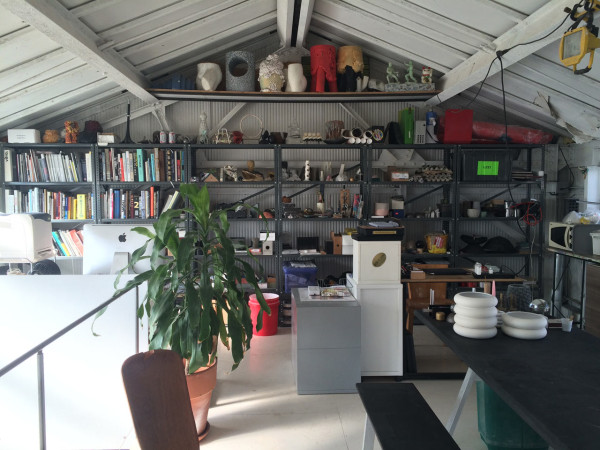New York-based Chen Chen & Kai Williams is a design studio launched by Chen Chen and Kai Williams in 2011 after meeting at Pratt Institute in Brooklyn where they studied industrial design. Shanghai-born Chen and native New Yorker Kai worked in studios that were close to each other before deciding to come together leading to their production of signature works in a variety of materials. For this month’s Where I Work, Chen gives us a look at the Brooklyn studio where they create an array of furniture and objects.
What is your typical work style?
Kai and I have a different preference on time of day. I prefer to get to the studio by 7AM and I try to leave at 6PM. Kai tends to stay later into the evening. This creates a few hours every day where we have the space totally to ourselves and the solitude really creates more mental space to focus.
What’s your studio/work environment like?
It’s always difficult to keep a studio space clean but especially so when you are doing mixed materials. We have stations for cement casting, stone polishing, resin casting, metal work and wood work. All those different types of dust, and moisture mixed together are terrible for our tools so we try to keep tidy as best as possible. We have a pet Roomba in the office that vacuums daily. We’ve also been lucky enough to have studio mates with dogs which are always a delight.
How is your office organized/arranged?
We have a downstairs work space / shipping area and an upstairs office. The office upstairs has a long conference table for meetings and doubles as a clean workspace for electronics. Kai and I have separate desks and behind that is our library of books and objects as well as important experiments for upcoming projects.
Downstairs there is a central work table and surrounding it are smaller work stations for more material specific tasks.
How long have you been in this space? Where did you work before that?
We’ve been in the space since 2014, before that we were in a ground floor space with a roll up gate on the end of Greenpoint Avenue. Kai originally had a CNC fabrication business there and I had a small studio a few blocks away. At that time Transmitter Park was still under construction. It was fenced from the street but open to our backyard so when the workers left at 3PM, we had a private waterfront park for 2 years.
If you could change something about your workspace, what would it be?
Less dust.
Is there an office pet?
Winden Jewelry shares space with us and Becca has an adorable dog named Ollie.
Do you require music in the background? If so, who are some favorites?
I really hate the way earphones create a disconnect between everyone in the room but often there’s machine noise in the background so it becomes the de facto way that we work. Both of us are mainly podcast listeners. Kai’s listened to History of the World in 100 Objects. I’m partial to Dan Carlin’s Hardcore History and Real Time with Bill Maher (all talk shows should be made into podcasts).
How do you record ideas?
We are terrible at sticking to a single platform. We have clipboards of paper with scrawled drawings, a combination of Asana and Slack and Clear which kind of defeats the purpose of having them. The major ideas as well as major events are written on ½” thick tempered glass tablets that are leaned against the wall. They used to be shelves at Moss which we took after the store closed.
Do you have an inspiration board? What’s on it right now?
Kai always says his source of inspiration is Wikipedia which is pretty much true. The app has a function that tells you of any noteworthy things in your vicinity which is absolutely amazing.
What is your creative process and/or creative workflow like? Does it change every project or do you keep it the same?
We have a pretty non-linear creative process. With self initiated projects we are often experimenting with materials until something presents itself to us. It’s not a top down approach where we’re pulling ideas out of our heads and making them happen. It’s difficult to apply a bottom up, experimental method to projects with a brief. The most successful solutions for those types of projects are often ideas that have been stewing in the back of our heads for years but with no clear outlet or application.
What kind of design objects might you have scattered about the space?
I used to work at Moss so we have a handful of damaged high design objects. This section of shelf has half of a shattered Julien Carretero Drag Light, a chipped Venini crystal trumpet from a $250K chandelier, a glued back together Studio Job candleholder produced by Makkum and a chipped Vitra mini of a Phillipe Starck stool.
Our most prized piece was gifted to us by Murray and Franklin, it’s a mold for casting invites to a Gaetano Pesce opening.
Are there tools and/or machinery in your space?
Lots! Although we used to own more. Kai used to own a 26,000lbs 17’ long CNC machine.
What tool do you most enjoy using in the design process?
Plumbers torch. You can use it to melt pewter for casting, heat treat epoxy to pop air bubbles or toast up some pita bread.
Let’s talk about how you’re wired. Tell us about your tech arsenal/devices.
We have a few Macs, nothing too crazy. We don’t use anything that high tech. It’s easy and cheap to have things 3D printed or laser cut with our vendors so there isn’t a need to acquire those tools.
What design software do you use, if any, and for what?
We use Rhino for technical drawings when we have to communicate with a fabricator. For the most part, it’s actually easier to make a miniature of the thing or mock it up in clay and scan it with 1-2-3-D (it’s a phone app). We find that miniatures in the actual material give you a better feel for things. Drawings and renderings for presentations can lie and sell something you can’t follow through with.
Is there a favorite project you’ve worked on?
Our collaboration with Tai Ping Carpets has been really amazing. We used designs from our Cold Cuts Coasters, scanned them and Tai Ping was able to translate them into beautiful hand tufted rugs. The original coasters were made by creating a composite of many different materials. Each color is a different material. Tai Ping was able to use a different type of fiber for each color in the rug. There are plastic cords, shoe laces as well as more traditional fibers like wool and silk. The original collaboration was in 2013 and shown in Miami, this last June they were released as a numbered edition in larger sizes that were shown in Paris.
Do you feel like you’ve “made it”? What has made you feel like you’ve become successful? At what moment/circumstances? Or what will it take to get there?
The key to creative success is continuously striving to do better. I think our default mode is not being satisfied with our current status and trying to figure out how to improve. At the same time, it is important to step back and look at the big picture of all the amazing things we’ve been lucky enough to be a part of. Next week we will be part of a show at Chamber next to a piece by Gaetano Pesce. That’s incredible that our work is being shown in context with his.
Tell us about a current project you’re working on. What was the inspiration behind it?
Our new Power Planters are something we’re really excited about. We were often asked about why our Stone Fruit Planters didn’t come with a saucer. With those cast fruit shapes, it was difficult to come up with a saucer that didn’t feel slapped on afterwards, this is the case with most saucers. Here we’ve designed the shape to be integrated. The bottom ring is the saucer so you have this nice reveal moment. The interior is glazed so there is no moisture passing through. The form was inspired by the ceramic insulators you find on high voltage power lines.
What’s on your desk right now?
This is Kai’s desk, it’s got machined brass components from our Gravity Well Pen, as well as some 3D printed mock ups of hooks we’re working on based on the forms from the Gravity Well Pen. The long metal piece is a connection we’re exploring for a collection of children’s stools that Kinder Modern will be showing at Pulse this December.
Do you have anything in your home that you’ve designed/created?
Both Kai and I have a Emerald Ash Bench at home. The idea came from a radio story about the Emerald Ash Beetle which was an invasive species destroying ash trees in North America. It gave me the mental image of an emerald dot on a piece of ash. Kai and I had already been trying to make a piece of furniture with ash because it has got great strength to weight ratio (the Superleggera chair as well as baseball bats are made of it). We used abalone shell circles normally used in guitar making to highlight the connections on the stool which borrow it’s proportions from a traditional bench found everywhere in Asia.










































